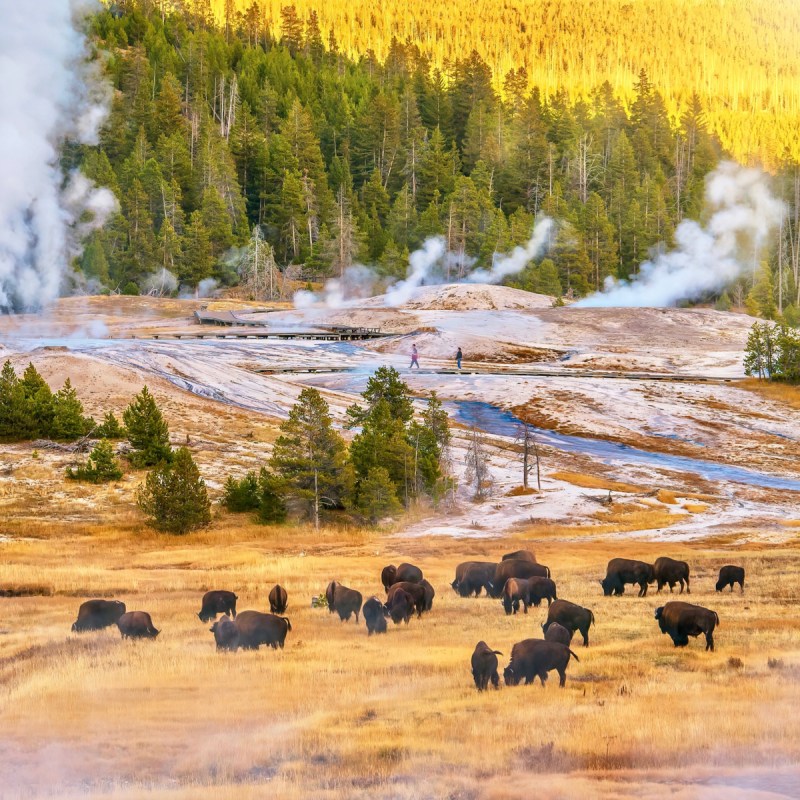
Officials at Yellowstone National Park recently made two important and timely announcements.
Videos by TravelAwaits
The first, which was expected at this time of year, is that the park’s roads are now closed to regular vehicles. Conversely, that means Yellowstone opened its roads to oversnow vehicles, or snowmobiles and larger, multi-passenger snow coaches.
The second announcement, however, certainly was surprising. Yellowstone officials announced that the park has suspended a wildlife monitoring program that restricted the number of winter vehicles allowed in the park.
The program, in effect since 2013, studied the impact of such vehicles on bison and other wildlife. Recent findings have determined that the presence of oversnow vehicles had minimal effects on the animals.
“Starting winter 2021/2022, Yellowstone National Park will suspend a wildlife monitoring effort because evaluations over the last decade have not substantially changed,” Yellowstone spokesperson Morgan Warthin explained. “This decision is consistent with the park’s Winter Use Adaptive Management Plan, which stated the National Park Service would continually re-examine and adjust winter use monitoring strategies and management actions as new information became available.”
A Controversial Plan
People began using snowmobiles in Yellowstone — located in parts of Wyoming, Montana, and Idaho — in 1963. The vehicles’ popularity surged because they made it easy to access remote parts of the park. Then, by the late 1990s, park estimates calculated that almost 800 snowmobiles entered Yellowstone every day in the winter.
However, as the National Park Service (NPS) points out, the ways “in which visitors access Yellowstone in winter can affect the park’s plants, animals, and wild character in ways more profound — and potentially more damaging — than at other times of the year.”
Driven by concerns that the growing number of snowmobiles were harming air quality and disrupting the park’s bison and other wildlife, the NPS began its wildlife monitoring program in 2013. Under that plan, which the NPS says “is one of the most contentious issues for park managers and visitors,” Yellowstone required winter visitors to travel in groups and only allowed 110 groups daily.
New Findings
New research found that being disturbed by snow machines was not “a primary influence on the distribution, movements, or population size and composition of bison, trumpeter swans, elk, coyotes, and bald eagles, the NPS reports.
The researchers observed more than 1,100 groups of animals during the 7 years the wildlife monitoring program has been in place. They found that 95 percent of observed bison and 81 percent of the observed trumpeter swans had either no response to nearby oversnow vehicles or they displayed a so-called “look and resume” response, which meant the animals looked up at the machines and then resumed what they were doing.
Know Before You Go
If you’re planning to visit Yellowstone this winter, keep in mind that most park roads are closed to automobiles but are open to snowmobiles and snow coaches. You can learn more about visiting Yellowstone by snowmobile or snow coach here.
You’ll also need to keep in mind that most of Yellowstone’s facilities are closed during winter. You can check the winter operating hours for visitor centers, stores, restaurants, campgrounds, lodges, and warming huts here.
Finally, Yellowstone’s rangers remind everyone to not approach or feed wildlife.
“Animals always have the right of way,” the rangers explain. “Expect to encounter bison and other wildlife on park roads. Slow down or pull over until they pass or move off the road.”
You can find more tips from Yellowstone’s rangers about visiting the park in the winter here.
While you’re thinking of a visit, be sure to read the rest of our Yellowstone coverage, including:
